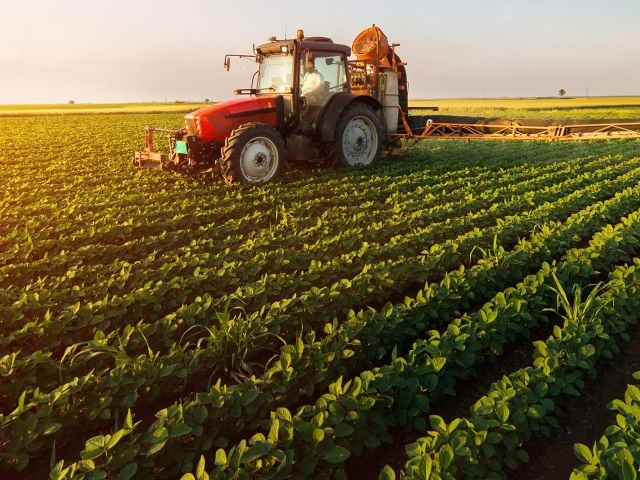
Thanks to five decades of bad policy decisions, a quirk of geology underlaying hundreds of thousands of acres of California's Central Valley has snowballed into a multi-million dollar taxpayer boondoggle that continues to pose an environmental threat to the fragile San Francisco/San Joaquin Bay-Delta estuary.
Much of the soil in the western San Joaquin Valley is loaded with selenium, a usually benign trace element that in high concentrations can be deadly to wildlife and humans. The selenium poses few problems -- until the land is irrigated for farming. Once that happens, selenium (and other salts) leach into groundwater and must be drained off the land to avoid poisoning the growing crops. But draining that polluted water into a stream or river causes further ecological problems.
The naturally high selenium content in the San Joaquin Valley has long presented serious barriers to farming. A 1990 report by the U.S. Department of Interior attributed the highly saline soil and poor drainage to the abandonment of farms more than a century earlier:
"Inadequate drainage and accumulating salts have been persistent problems in parts of the [San Joaquin] valley for more than a century, making some cultivated land unusable as far back as the 1880s and 1890s. Widespread acreages of grain, first planted on the western side of the valley in the 1870s and 1880s were irrigated with water from the San Joaquin and Kings rivers. Poor natural drainage conditions, coupled with rising ground-water levels and increasing soil salinity, meant that land had to be removed from production and some farms ultimately abandoned" (SJVDP 1990).
While water is scarce in the Central Valley, sunshine and good weather are abundant, making the area appear attractive for farming, despite the problems posed by selenium. In the 1940s and 1950s San Joaquin farmers hoping to expand farming operations lobbied the federal Bureau of Reclamation to extend the California Central Valley Project (CVP) – a massive taxpayer-funded water delivery system – to the region (Westlands 2010).

credit: Lawrence Berkeley Nat'l Lab - Roy Kaltschmidt, photographer
The farmers knew that long-term irrigation would be impossible without some kind of drainage system to funnel selenium-polluted water away from their fields. So when a group of San Joaquin farmers signed a contract with the federal government to create the new "Westlands Water District," they made sure that the contract contained a provision requiring the federal government to provide both irrigation water and drainage for those areas where selenium was a particular problem (Westlands 2010). Unfortunately, the Bureau of Reclamation didn't consider the potential environmental damages of draining off the polluted water when it agreed to provide irrigation water to Westlands.
Farmers receiving Central Valley Project water were supposed to repay taxpayers $1.1 billion against the project's $3.6 billion price tag. Under law, the farmers should have paid off this debt within 50 years after the CVP was completed (DOI 1997). The precise deadline remains a matter of debate but this much is certain. In 2008 (the most recent year for which data is available) — 65 years after the water began flowing — farmers benefitting from this project had paid back only 20 percent of their obligation under the law (USBR 2010a). According to Bureau of Reclamation documents, in 2008 Westlands still owed $367 million dollars to taxpayers, 82 percent of their debt (USBR 2010a).
In addition to being a financial mess, the Central Valley Project has caused a number of environmental problems. One of the worst was directly related to irrigating the high selenium soils in Westlands Water District. In order to provide drainage to thousands of acres of farmland, the Bureau of Reclamation constructed the San Luis Drain – a mostly unlined canal that funneled selenium-laced wastewater away from Westlands and into Kesterson National Wildlife Refuge in Merced County. There, the compound concentrated in the shallow waters and aquatic vegetation, poisoning birds and other wildlife (NRC 1989).
In 1982, scientists observed record numbers of migratory birds at Kesterson hatching with massive deformities. Baby birds had grossly misshapen beaks, twisted legs, missing wings and malformed skulls. More than 1,000 waterfowl died (NRC 1989). This discovery has come to be known as the Kesterson disaster.
Floyd Dominy, head of the Bureau of Reclamation from 1959 to 1969, acknowledged in 1997 that the decision to build a water delivery system to what would become Westlands Water District "a terrible mistake":
"We went ahead with the Westlands project before we solved the drainage problem. We thought we knew how to solve the drainage problem. We thought the Kesterson Reservoir could be flushed on out into the [San Francisco/San Joaquin Bay] Delta. We didn't have it solidified. So I made a terrible mistake by going ahead with Westlands at the time we did." (Else and Harrar, 1997)
Bureau of Reclamation officials closed the San Luis Drain in 1985, but they did not come up with a new way to drain selenium-fouled water. In 1998 Westlands sued the federal government for breach of contract and demanded a drainage system, as the contract specified. In 2000 a Federal Appeal Court ruled that although the government's duty to provide drainage was not excused, the government had discretion to satisfy its duty in alternate ways (see Firebaugh Canal Co. v. United States, Nos. 95-15300 & 95-16641, Feb. 4, 2000). In other words, the government could legally choose to buy out land owners and retire the land instead of providing drainage. The Bureau of Reclamation was tasked with determining the economic and environmental feasibility of various alternatives. Its conclusions were set in a 2007 document called the "Record of Decision" (USBR 2007).
As required by federal law, the agency conducted a National Economic Development account analysis that calculated the net economic gain or loss that would be generated by different solutions. Among the options it weighed:
-- Retire 140,894 acres of Westlands farmland plus 14,467 adjoining acres north of the District known as the Grasslands Drainage Area. Spend federal dollars to build drainage and treatment facilities for the remaining 113,000 selenium-impaired acres within Westlands and another 66,533 acres selenium impaired acres in Grasslands. Economic loss: $10.2 million a year.
--Retire all 253,894 selenium-impaired acres in Westlands plus 14,467 acres in Grasslands. Spend federal dollars to build drainage and treatment facilities for 66,533 selenium impaired acres in Grasslands. Economic gain: $3.6 million a year.
Oddly, the agency proposed to move ahead with the money-losing option, involving construction of new drainage and treatment systems in Westlands and Grasslands. Because federal rules require that agencies select alternatives with the greatest net economic benefits, Bennett Raley, Assistant Secretary of Water and Science at the Interior department, under the George W. Bush Administration, was required to issue a special exemption (WRC 1983).
Fortunately, Congress and the Obama Administration summarily rejected the Bureau of Reclamation plan. While plans for a drainage system in Grasslands moved forward, agency officials went back to the drawing board and came up with a new proposal for Westlands. Bureau of Reclamation commissioner Michael Connor outlined the new plan in a September 1, 2010, letter to U.S. Senator Dianne Feinstein, D-Calif. (Connor 2010).
Unfortunately, the agency's latest plan is just as problematic as the previous one. Among other things, it would:
- Require the federal government to pay to build drainage and treatment facilities for a subsection of the selenium tainted land within Westlands, with the District itself footing the bill for additional drainage and treatment facilities to service acres remaining in production;
- Forgive some or all of Westlands' $497 million debt to taxpayers;
- Transfer ownership of "appropriate" elements of San Luis Unit, a federal-state water infrastructure complex of dams, reservoirs, canals, pumping plants and a power generation station, to Westlands if requested. (According to the Bureau of Reclamation website, the federal government owns the San Luis Drain, the O`Neill Pumping Plant and Intake Canal, Coalinga Canal and Pleasant Valley Pumping Plant. The federal and California state governments jointly and operate O`Neill Dam and Forebay, B.F. Sisk San Luis Dam, San Luis Reservoir, William R. Gianelli Pumping-Generating Plant, Dos Amigos Pumping Plant, Los Banos and Little Panoche Reservoirs, and San Luis Canal from O`Neill Forebay to Kettleman City, with switchyard facilities (USBR 2010b).)
- Extend Westlands' water contract length beyond the standard 25 years;
- Provide federal incentives for renewable energy development within Westlands;
- Require Westlands to retire 200,000 acres of selenium-tainted land (it is unclear from the proposal whether this figure would include or would be in addition to already retired land);
- Reduce Westlands' water deliveries proportional to the amount of land retired, but only in years with very high rainfall.
EWG found that between 2005 and 2009, the federal government issued a total of $22.4 million dollars in direct payment subsidy checks (subsidies that are based on historical production of commodity crops) and $31.6 million dollars in counter-cyclical payment subsidy checks (subsidies that fluctuate with the prices of agricultural commodities) to 356 individuals. The five-year total for both subsidy categories was $54 million, or an average of $10.8 million per year. [Click here to see a list of all subsidy recipients.]
US taxpayers paid nearly $60 million to farmers on Westlands' toxic lands
| USDA Program | 2005 | 2006 | 2007 | 2008 | 2009 | 2005-2009 |
|---|---|---|---|---|---|---|
| Total Counter Cyclical Payments | $4,889,606 | $5,296,624 | $4,892,962 | $8,065,279 | $8,437,075 | $31,581,546 |
| Total Direct Payments | $2,774,538 | $3,545,068 | $7,859,278 | $5,157,648 | $3,066,575 | $22,403,107 |
| Total | $7,664,144 | $8,841,692 | $12,752,240 | $13,222,927 | $11,503,650 | $53,984,653 |
EWG's calculations are conservative. While the National Economic Development analysis found in the Bureau of Reclamation's 2007 Record of Decision document listed 253,894 acres within Westlands in need of drainage (along with another 44,106 acres that had already been retired), when EWG analyzed the agency's maps contained in this same document, we found that the drainage impaired area shown comprised only 220,000 acres (USBR 2007). The reasons behind this discrepancy remain unclear, and the Bureau of Reclamation was unable to provide the underlaying geographical information system (GIS) data used to produce the maps to EWG. For these reasons, EWG was only able to calculate subsidy checks going to 220,000 acres of the 253,894 acres the agency has stated is in need of drainage.
In addition, EWG confined its analysis to the two most important types of subsidies (direct payments and counter cyclical subsidies) provide to Westlands. We did not consider the 13 other kinds of subsides categories that farmers benefitted from during the 2005-2009 period. These additional subsidies, which included disaster payments and dairy subsidies among others, accounted for another $2 million per year.
The Bureau of Reclamation's 2007 National Economic Development analysis ignored the issue of taxpayer-funded crop subsidies (USBR 2007). Yet it considered an incredibly wide range of other economic benefits and costs, such as:
- Increased net revenues that are a result of continuing to irrigate those drainage-impaired lands that would otherwise have to be removed from agricultural production due to inadequate drainage;
- Increased net revenues resulting due to a change from a salinity- and water-restricted crop mix to a more revenue intensive crop mix on drainage-impaired lands;
- Reduced costs of irrigation management practices by providing drainage service to drainage impaired lands;
- Costs associated with treatment and disposal of high selenium drainage water including: remaining post authorization planning and design costs; construction costs; construction contingency costs; administrative services costs; fish and wildlife habitat mitigation costs; relocation costs; historical and archaeological salvage costs; land, water, and mineral rights costs; and operation, maintenance, and replacement costs;
- Costs of voluntary and/or involuntary land retirement;
- Costs of supplemental water purchases.
It is simply inappropriate to exclude crop subsidies when considering the potential economic costs and benefits of various alternatives in Westlands. Subsidy payments are real cost outlays by the federal government, and are easy to calculate since they have hard numbers attached – unlike many of the projected changes in revenues associated with different action alternatives. Subsidy payments have also been ongoing for decades, and are unlikely to disappear anytime soon (EWG 2010).
When U.S. taxpayers' annual expenditure of $10.8 million in crop subsidies is taken into account, the cost of continuing to farm Westlands' 250,000 troubled acres becomes exorbitant. There is only one solution that makes sense for the great majority of Americans: retire the selenium-laced land from farming and transition it to other uses that would be less costly to taxpayer and the environment, and provide the nation more benefit. One option is to use the land for renewable energy production, something in which both Westlands and the Department of the Interior have expressed interest.
The selenium laced land simply cannot sustain farming at a reasonable cost to the taxpayers, and with adequate protection for California's invaluable, fragile wildlife habitat.
Conclusion and Recommendations
The time is nearing when federal agencies and Congress must finally settle on a long-term solution for Westlands' toxic lands. The stakes are high. Among them:
- More than a half-billion dollars worth of taxpayer money. If the Bureau of Reclamation forgives Westlands' $497 million debt, and spends untold millions on new drainage facilities for the toxic lands, and continues to pay crop subsidies for the land that is not retired, the total cost to the U.S. taxpayer would amount to more than a half-billion in the first year. In contrast, if all of the problem lands were permanently taken out of production and the crop subsidies discontinued, this would save taxpayers more than $10 million dollars per year. Over the next 50 years, this savings of more than $500 million could alone pay for much of the cost of land retirement.
- Hundreds of thousands of acre-feet of water in the drought-prone West. The Bureau of Reclamation has contracted to supply Westlands Water District with 1.1 million acre-feet of water per year. If 250,000 acres of Westlands farmland – almost a third of the entire water district – are retired, hundreds of thousands of acre-feet of water would be freed up for other uses. With California's ongoing drought problems and growing population, the gains would be significant. An average family of 4 in California uses between one-half and one acre-feet of water per year. The Department of Interior's new proposed plan, as it was written in the agency's September 1, 2010 letter to Feinstein would only net this water savings in years when there was very high rainfall in California.
- The health of the fragile San Francisco-San Joaquin Bay/Delta. Water with intense selenium concentrations now drains from Westlands into ground waters and then into the San Joaquin River, which in turn flows into the San Francisco-San Joaquin Bay/Delta estuary. The Bay/Delta ecosystem, an important natural resource for California and the nation, is being harmed by the high selenium loads. California's water quality objective for selenium in still and flowing waters is 2 and 5 parts per billion (ppb) respectively. The federal EPA drinking water standard for selenium is 50 ppb. The selenium level for the San Joaquin River upstream of the Merced River was 52 ppb in January 2010, and continually exceeded the 5 ppb objective since August 2009. More than 41,000 acres of the Bay-Delta estuary downstream is listed as impaired by selenium contamination. The toxic mineral bioaccumulates in various species. Selenium makes its way through the California Aqueduct into southern California's water supplies, where it may bioaccumulate in fish and other species.
- The potential for a second Kesterson disaster. The Bureau of Reclamation's plan to collect and treat toxic drainage water would be expensive, and there is no guarantee it would actually work. Collecting contaminated drainage water could create another Kesterson-like catastrophe if done improperly. Treatment itself is untested. The agency has proposed deploying reverse osmosis (RO), an energy-intensive filtration process that has never been used to treat selenium-polluted water on such a large scale. The highly concentrated chemical brine left over after RO treatment would have to be disposed of at a toxic waste dump.
- Future litigation costs to taxpayers. The 298,000 acres of toxic land in Westlands has been the subject of repeated, costly litigation. Only by retiring all of this land permanently will the U.S. put to rest the threat of future such litigation.
The true costs of farming on Westlands' toxic lands cannot be justified by any measure – economic or environmental. The time has come to fix the Bureau of Reclamation's costly mistake and retire all of the selenium tainted land in Westlands.


